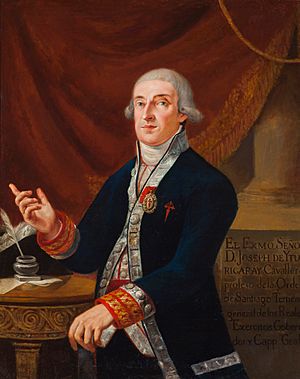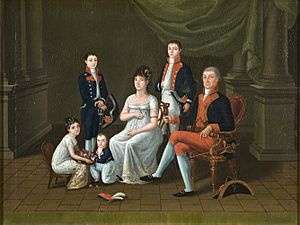José de Iturrigaray facts for kids
Quick facts for kids
The Most Excellent
José de Iturrigaray
|
|
|---|---|

Portrait by an Unknown Artist
|
|
| 56th Viceroy of New Spain | |
| In office 4 January 1803 – 16 September 1808 |
|
| Monarch | Charles IV |
| Preceded by | Félix Berenguer de Marquina |
| Succeeded by | Pedro de Garibay |
| Personal details | |
| Born |
José Joaquín Vicente de Iturrigaray y Aróstegui de Gaínza y Larrea
June 27, 1742 Cádiz, Spain |
| Died | August 22, 1815 (aged 73) Madrid, Spain |
| Spouse | María Inés de Jáuregui y Aróstegui |
| Military service | |
| Allegiance | |
| Branch/service | Spanish Army |
| Rank | General |
| Battles/wars | Seven Years' War War of the Pyrenees War of the Oranges |
José de Iturrigaray (born June 27, 1742, in Cádiz, Spain – died August 22, 1815, in Madrid) was a Spanish military officer. He served as the Viceroy of New Spain from 1803 to 1808. This was a very important time because Napoleon had invaded Spain. Iturrigaray tried to create a temporary local government in New Spain. However, this led to his arrest and removal from power.
Contents
Early Life and Military Career
José de Iturrigaray came from a wealthy family of merchants in Cádiz, Spain. His parents were from the Basque region of Spain.
He began his military career under King Charles III. In 1762, he fought in the Spanish invasion of Portugal. He also took part in the Great Siege of Gibraltar. Later, under King Charles IV, he became known for his bravery. This was during the War of the Pyrenees against France in 1793. In 1801, he was the commander of the army in Andalucía during the War of the Oranges with Portugal.
Viceroy of New Spain (1803-1808)
After serving as governor of Cádiz, Iturrigaray was chosen to be the viceroy of New Spain. He arrived in the colony in 1803 with his wife, María Inés de Jáuregui y Aróstegui. People liked him because he was friendly and cheerful. This was a big change from the serious viceroy before him.
Iturrigaray worked to improve things in New Spain. He visited the state of Guanajuato to open a public granary. He also checked on the mines there. He even gave permission for a new bridge to be built in Celaya.
On December 9, 1803, he officially opened a large bronze statue of King Charles IV. This statue was in the main square of Mexico City.
Important Visitors to New Spain
In March 1803, a famous explorer named Baron Alexander von Humboldt arrived in Acapulco. Humboldt spent a year exploring New Spain. Viceroy Iturrigaray helped him with his research. Humboldt later wrote an important book about the region.
Another important visitor was Dr. Francisco Javier de Balmis. He arrived in March 1804 with an expedition to spread the smallpox vaccine. The viceroy's son was one of the first to be vaccinated.
Growing Problems and Discontent
In 1805, Spain declared war on Britain again. Iturrigaray was told to prepare the colony for defense. He also had to send more money to Spain. To do this, he used a special order that took money from church properties. This made many people unhappy.
People in New Spain were also upset about higher taxes. Spanish people born in Spain (called Peninsulares) were unhappy because Iturrigaray seemed to favor people born in America (called Criollos). The Criollos, on the other hand, started to think about becoming independent.
The Situation in Spain (1808)
In 1808, Napoleon's French army invaded Spain. The Spanish royal family tried to leave Madrid, but people were angry. A riot broke out, and King Charles IV was forced to give up his throne to his son, Ferdinand. However, Napoleon later captured both Charles and Ferdinand. Napoleon then made his own brother, Joseph Bonaparte, the new king of Spain.
On May 2, 1808, the people of Madrid fought back against the French. This started a rebellion across Spain. Many local councils, called juntas, were formed. They claimed to govern Spain in the name of the captured King Ferdinand VII.
New Spain's Response to the Crisis
News of the invasion of Spain reached Mexico in June 1808. Then, in July, news arrived that the Spanish king had given up his throne to Napoleon.
The city council of Mexico City, called the Cabildo, suggested a bold idea. They said that since the Spanish throne was taken by an outsider, the power should go to the viceroy. He would then refuse to recognize the new French rule in Spain. Viceroy Iturrigaray agreed with this idea.
However, the Audiencia, which was another powerful council, disagreed. Most of its members were Spanish-born. They argued that New Spain was a colony and could not make such big decisions.
Calls for a Mexican Congress
The Criollo party wanted to form a local governing council (a junta), just like in Spain. They also wanted to call a congress of representatives from New Spain. The Audiencia continued to oppose this.
On August 9, 1808, a lawyer named Primo Verdad y Ramos spoke about the idea of popular sovereignty. This meant that power should come from the people. Some judges from the Audiencia called this idea dangerous.
On August 31, 1808, the situation became even more tense. Representatives from different Spanish juntas arrived in New Spain. They all asked New Spain to recognize them as the true government of Spain. This showed that there was no clear, single government in Spain.
On September 1, 1808, a priest named Melchor de Talamantes, a leader of the Criollo party, argued for New Spain to separate from Spain. He said that since the king was gone, power should now belong to the people of New Spain.
It seemed like a fight might break out between the Spanish-born people (who supported the Audiencia) and the Criollos (who supported the Cabildo).
The Coup Against the Viceroy
Viceroy Iturrigaray seemed to favor the Criollo party. He had received their requests for a congress. He had also given important jobs to Criollos. He even moved a military regiment closer to Mexico City, which was led by his friend.
On September 15, 1808, a group of Spanish-born people, led by Gabriel J. de Yermo, decided to act. About 500 armed people attacked the viceroy's palace in the early morning. They arrested Iturrigaray. Members of the city council were also arrested.
After his arrest, Iturrigaray was taken to the Inquisition building. This was done to make people think he was removed for religious reasons. His wife and children were also taken away. An inventory of Iturrigaray's belongings was made. It showed he had a lot of wealth, which made people suspect he had used his position for personal gain.
A new viceroy was chosen quickly. It was the oldest and highest-ranking military officer, Marshall Pedro de Garibay. He was an old man and was easily controlled by the Audiencia.
The Criollo leaders, Primo Verdad y Ramos and Melchor de Talamantes, were put in jail. They both died there.
Return to Spain
On September 21, 1808, Iturrigaray was sent back to Spain as a prisoner. He was put on trial in Cádiz for not being loyal. The charges were not fully proven, and he was later set free. However, a legal process continued after his release. It ended only when Iturrigaray died in 1815. He was ordered to pay a large fine.
|
See also
 In Spanish: José de Iturrigaray para niños
In Spanish: José de Iturrigaray para niños


